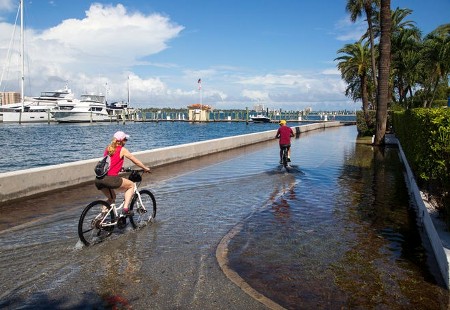
One of the strangest aspects of the real estate market in Florida is the continuing rise in the prices of homes within spitting distance of oceanfronts where sea level rise is already very apparent.
Take, for example, the town of Palm Beach. Since 1895, average annual temperatures have risen by 1.28 Celsius (2.3 Fahrenheit) degrees. That’s faster than the global average which is about 1.1 Celsius (just under 2 Fahrenheit). Meanwhile, in the last three decades, sea levels have risen 15 centimetres (6 inches). The rate of sea-level rise in the near future is expected to match that number again in half the time.
If you have ever driven through Palm Beach, and I have, you immediately note one thing. This place is flat with little in elevation separating it from the Atlantic to the east. There is no place nearby to pitch a tent in the event your home along the coast becomes inundated by rising seas or storm surges.
Forecasts point to the inevitability of just such an outcome in the near future. Take, for example, a recent University of South Florida study that shows houses along the coast of Palm Beach, Broward, and Miami-Dade counties likely to experience significantly increased floods in the next few decades resulting in declining real estate values.
In another university study done in 2017 by Florida State researchers, it predicted the South Florida region would likely lose 2.5 million people by 2040 as sea levels rose. Yet, the 2020 census displays a very different reality with the state gaining more than that number just in the last ten years.
And yet another study done by the Centre for Climate Integrity recently noted that Florida needs to spend $75.9 billion US on seawalls along its Atlantic and Gulf of Mexico coastlines between now and 2040 with the Palm Beach budgeted portion at $544 million.
Despite all these dire messages, it appears the moneyed class of Palm Beach are not unnerved and are responding by building their homes higher, and erecting private sea walls and flood gates on their estates. As Amanda Gordon, who writes for Bloomberg notes, the local millionaires and billionaires of Palm Beach are indifferent to all of these warnings of climate change and sea-level rise.
Why is that? She concludes the following: With an average age of over 65, many Palm Beach residents don’t believe they will be around long enough to see sea levels reach their multimillion-dollar homes. And others with money to burn, should the inevitable occur, don’t seem to think it is such a big deal should they have to up and move to build again.
So there is a building boom in Palm Beach and on Palm Beach Island which serves as a barrier to the mainland from the rising Atlantic Ocean. The boom is seeing bigger and more expensive homes being erected in high flood-risk zones. Structures are being raised on stilts and pilings and outfitted with breakaway walls designed to collapse in the face of a flood without damaging the homes’ main structures. Private flood gates are being installed and sea walls are being heightened.
But not everybody in Palm Beach is rich. The town leadership back in 2012 commissioned a report from the Woods Hole Group, a consulting firm, to do a technical review of coastal management. In its report, it noted that although the town’s coastal preparations were more advanced than most communities, the existing measures in place along with coastal structures were inadequate to meet the long-term sea-level threat.
It pointed out that the entire extent of Palm Beach as a barrier island was vulnerable to flooding and wave damage. The vulnerability, it noted, extended to low-lying areas inland, and pointed out the increased risk of having assets positioned on the coast. It also noted the likelihood of a future storm exceeding existing infrastructure design criteria leading to more destructive outcomes. The plan which looks at existing beach berms designed to protect against a 25-year storm, notes that there is a 4% chance in any given year of the protection failing particularly in the light of increased storm frequencies and wave heights in the face of climate change and sea-level rise.
One thing is abundantly clear. Palm Beach like much of South Florida, whether on the Atlantic or Gulf side, will not look or be the same by century end. For the government of Palm Beach and the town to survive, it probably means existing homes will need to be raised or razed. If the former it means ground floors being sacrificed to the rising Atlantic. If the latter, it means moving away.
The town of Palm Beach has building code rules that require anyone wanting to renovate or rebuild must seek its approval. This policy is likely to trigger one of three outcomes:
- People doing nothing and watching the unfolding disaster occur. The stoics among us.
- Or people complying with the town’s plans to mandate seawalls and flood mitigation measures.
- Or people leaving Palm Beach.
Whatever happens here will be playing out in coastal towns and cities along the Atlantic and Gulf (and probably the Pacific) coasts over the coming decades. And despite rich homeowner indifference, if the town does it right for the majority of its citizens, other communities will learn from it and follow the lead.








